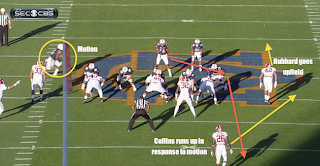Confusion
Auburn's offense is not complicated. I think I counted six different run plays in the Iron Bowl, and the vast majority were inside zone read with various tags added on (such as bubble screens). What makes Auburn's attack so difficult to defend is (1) the tempo and (2) the untraditional formations and frequent motions. When a defense is tired and having to adjust to motion, it's easy for a player to blow an assignment. Alabama is one of the more disciplined teams in the country, but even they were not immune.
On this play, one the the H-backs motions across the formation. After a moment, Alabama linebacker C.J. Mosley runs up to the line and appears to be trying to get the defensive line to shift. He's out of position at the snap. Meanwhile, #20 Jarrick Williams, who plays the "star" position in Saban's defense (basically a nickelback), doesn't move over to mirror the shift until it's too late. He is easily sealed inside by the same player who went in motion, which enables Auburn quarterback Nick Marshall to get around the edge. This would be a frequent problem for the Tide, but I'll get to that.
That example was rather harmless, especially since the play was called back for holding. The next example went 45 yards for Auburn's first touchdown.
The Tigers motion a receiver across the formation in a jet sweep look but run inside zone read with the back, a play they would run frequently. I don't know exactly what the responsibilities were here, but I do know that two Bama players — #42 Adrian Hubbard and #26 Landon Collins — both responded to the jet motion. That's a problem.
With Hubbard chasing the motion man upfield and Collins running up to cut the motion man off, there's a huge lane for Marshall. During the broadcast, Gary Danielson also pointed out Mosley (#32), the linebacker in the middle who shuffles himself out of the play. This defensive front wasn't the one Alabama used most of the day, and this is the only time Auburn ran this play against this front, so I'm not sure how it should have played out. However, I suspect Collins was responsible for the sweeper (that's how most teams do it). In that case, Hubbard needed to respond to the left tackle's down block by shuffling inside, which would have constricted the gap that Marshall ran through. This would have forced Marshall to cut inside where Mosley could make the play*.
* I should say where Mosley could make the play were it not for the fact that defensive end Jeoffrey Pagan got driven five yards back. This was another common theme I'll get to later.
Contain
Alabama's sophomore cornerback Cyrus Jones had a rough night. Auburn ran at him a lot, and Marshall threw the game-tying touchdown pass over his head off one of those inside zone read plays that had the X receiver running a sort of casual fade as a third option. (I was surprised to see that the Tigers actually ran this play a couple of times earlier in the game. It wasn't some gadget they unveiled at the last moment.)
Most notably, Jones struggled with his responsibilities as a run force player; it was frequently his job to "set the edge" on outside runs to his side in order to force the ballcarrier back inside to pursuing defenders. Here is senior corner Deion Belue (#13) showing what setting the edge is supposed to look like (attack the block, keep your outside arm free and stay on your feet):
I don't want to be too harsh on Jones, so I'll only add one gif.
Jones is the cornerback on top, wearing the #5 jersey. He is late attacking the block and doesn't keep leverage to the outside. I counted three more plays in which Jones failed to set the edge; those four plays resulted in 56 rushing yards for the Tigers. To be fair, Jones was not the only player who had trouble on the outside — Williams (mentioned earlier when he was slow to respond to motion) lost contain at least once, and most of the defensive backs missed at least one tackle on the outside at some point.
The Trenches
Finally, it would be a disservice to paint Auburn's offense as "finesse." The Tigers' offensive line, particularly sophomore left tackle Greg Robinson (#73) and redshirt freshman left guard Alex Kozan (#63), were often dominant.
Alabama's Pagan, who was mentioned earlier, had an especially tough time early in the game. (He got better as the game progressed.) Notice where the line of scrimmage is in the image above.
A few seconds into the play, Robinson and Kozan have driven Pagan nearly three yards back and into the pursuit path of Mosley.
Here's another example.
After the snap, Robinson and Kozan have walked Pagan another three yards off the line and into a linebacker. Combo blocks are very difficult for any player, but ideally Pagan would fight the blockers to a stalemate or, if he can't, drop to the ground, taking them down with him and creating a pile. This not only creates an obstruction for the ballcarrier, but it also prevents the combo blockers from reaching the second defender they're trying to get to, usually a linebacker.
I want to be fair to Pagan, so here's a picture of freshman A'Shawn Robinson also being dominated by the combo block of Robinson and Kozan. (He was actually pancaked a split second after this.)
Late in the game, Alabama began using more 3-4 fronts, stunts and corner blitzes. The defensive line play improved, and they even threw in some trap coverages to try to bait Marshall into throwing an interception. These efforts were relatively successful; Auburn was held to 64 rushing yards on 15 attempts in the fourth quarter and 4.67 yards per play. But it was too little too late.










No comments:
Post a Comment